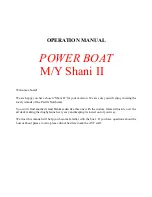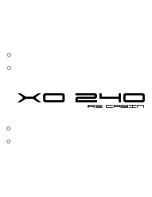
F
R E E D O M
2 8 5
8–12
Using Discharge Seacock (Overboard)
1. Locate the Y-valve mounted on the forward bulkhead in the forward bilge compartment.
Place the Y-valve handle in the overboard discharge position.
2. Open the head discharge seacock by pulling up on the remote seacock arm. This seacock is
located under the access plate in the forward bilge compartment.
3. Turn on the head pump switch at the helm and discharge until the reservoir is empty. Close
the discharge seacock (handle in the horizontal position).
“Portable Head With In-line Macerator” on page 8–25
L
IVEWELL
- R
AW
W
ATER
To operate the livewell, open the seacock with the livewell I.D. tag located in the port aft
bilge. The livewell pump is screwed directly into this seacock. The livewell switch at the helm
should be in the “on” position. Water will enter through a plenum along the side of the livewell
and be distributed through a series of holes arranged vertically along the plenum. The water will
rise until it reaches the top overflow drain on the plenum at which point it will drain overboard.
See
“Livewell/Washdown Layout” on page 8–22
O
UTRIGGERS
The optional outriggers spread the fishing lines being trolled from your boat and decrease the
chance of entanglement.
• Advantages
Advantages of outriggers include offering bait throughout a larger area behind the boat,
placing bait out of the wake zone, automatic drop back following strikes (which allows for
fish to completely accept bait), and a reduction in unnecessary twisting action characteristic of
artificial bait.
• Instructions
For installation and use, reference the sheet included in your Owner’s Packet.
N O T I C E
Overboard discharge seacock must be secured in the “closed” position in accordance with the
laws in your boating area.
N O T I C E
If the livewell seacock is left open and the pump is not on, the boat’s forward motion through the
water will gradually fill the box. To prevent this inadvertent filling, close the seacock when the
livewell is not in use.
Under certain conditions, placing the outboard engine(s) in reverse will ventilate the water under
the boat and create an air lock in the livewell pump. To prevent this situation from occurring, it is
recommended the livewell be turned off prior to any high RPM or continuous reverse operation.
If the livewell pump becomes air-locked, correct this situation by turning the pump off for 20
seconds.
Summary of Contents for Freedom 285
Page 2: ......
Page 10: ...W E L C O M E 1 4 ...
Page 18: ...S A F E T Y 2 8 ...
Page 26: ...G E N E R A L I N F O R M A T I O N 3 8 ...
Page 48: ...M A I N T E N A N C E A N D S E R V I C E 6 12 ...
















































